Assessing Phytosanitary Application Efficiency of a Boom Sprayer Machine Using RGB Sensor in Grassy Fields
Abstract
:1. Introduction
2. Materials and Methods
2.1. Experimental Conditions
- Zi: average fungicide level at test tube i (mm);
- ¯Z: average fungicide level applied to the treated area (mm);
- N: number of observations.
2.2. Data Collection
2.3. Image Processing
2.4. Statistical Analysis
3. Results and Discussion
3.1. Nozzle Size and Pressure and Their Effect on the Uniformity Coefficient
3.2. Effect of Nozzle Size on the Distribution Quality
3.3. The Performance of Remote Sensing Indices Assessing Grass Healthy Status
3.4. Multiple Linear Regression (MLR) Model
4. Conclusions
Author Contributions
Funding
Institutional Review Board Statement
Informed Consent Statement
Data Availability Statement
Acknowledgments
Conflicts of Interest
Abbreviations
| GPS | Global positioning system |
| GNSS | Global navigation satellite systems |
| VRT | Variable-rate technology |
| RGB | Red-green-blue |
| HTPP | Hight throughput plant phenotyping |
| VNIR | Visible and near-infrared |
| NDVI | Normalized difference vegetative index |
| RGB VIs | Red–green–blue vegetation indices |
| TIR | Thermal infrared |
| NGRDI | Normalized green–red difference index |
| TGI | Triangular greenness index |
| HIS | Hue–intensity–saturation |
| H | Hue |
| GA | Green area |
| GGA | Greener green area |
| CSI | Crop senescence index |
| BPS | Boom pressure sprayer |
| CHS | Conventional hydraulic slot nozzle |
| Cu | Uniformity coefficient |
| FL | Flow rate |
| NIR | Near-infrared |
| ANOVA | Analyses of variance |
| R2 | Determination coefficient |
| RMSE | Root mean squared error |
| MLR | Multiple linear regression |
| UAV | Uncrewed aerial vehicle |
References
- Pontes, L.; Maire, V.; Schellberg, J.; Louault, F. Grass strategies and grassland community responses to environmental drivers: A review. Eur. J. Plant Pathol. 2015, 35, 1297–1318. [Google Scholar]
- Pepitone, J. Hacking the farm: How farmers use “digital agriculture” to grow more crops. CNN Money 2016. Available online: https://money.cnn.com/2016/08/03/technology/climate-corporation-digital-agriculture/index.html (accessed on 3 August 2016).
- Grell, M.; Barandun, G.; Asfour, T.; Kasimatis, M.; Collins, A.; Wang, J.; Guder, F. Determining and Predicting Soil Chemistry with a Point-of-Use Sensor Toolkit and Machine Learning Model. bioRxiv 2020, 9, 1–27. [Google Scholar] [CrossRef]
- McBratney, A.; Whelan, B.; Ancev, T. Future Directions of Precision Agriculture. Precis. Agric. 2005, 6, 7–23. [Google Scholar] [CrossRef]
- Whelan, B.M.; McBratney, A.B. Definition and Interpretation of potential management zones in Australia. In Proceedings of the 11th Australian Agronomy Conference, Geelong, Victoria, 2–6 February 2003; pp. 2–6. [Google Scholar]
- Schieffer, J.; Dillon, C. The economic and environmental impacts of precision agriculture and interactions with agro-environmental policy. Precis. Agric. 2015, 16, 46–61. [Google Scholar] [CrossRef]
- Sophocleous, M.; Georgiou, J. Precision agriculture: Challenges in sensors and electronics for real-time soil and plant monitoring. In Proceedings of the IEEE BIOCAS 2017 Biomedical Circuits and Systems Conference, Torino, Italy, 19–21 October 2017; pp. 1–4. [Google Scholar]
- Sophocleous, M. IoT Thick-Film Technology for Underground Sensors in Agriculture. 2016. Available online: https://www.fierceelectronics.com/components/iot-thick-film-technology-for-underground-sensors-agriculture (accessed on 23 November 2021).
- Kefauver, S.C.; El-Haddad, G.; Vergara-Diaz, O.; Araus, J.L. RGB picture vegetation indexes for High-Throughput Phenotyping Platforms (HTPPs). In Proceedings of the SPIE Conference on Remote Sensing for Agriculture, Ecosystems, and Hydrology XVII, Toulouse, France, 22–24 September 2015. [Google Scholar]
- Ouled Taleb Salah, S.; Duchesne, A.; De Cock, N.; Massinon, M.; Sassi, K.; Abrougui, K.; Lebeau, F.; Dorbolo, S. Experimental investigation of a round jet impacting a disk engraved with radial grooves. Eur. J. Mech. B Fluids 2018, 72, 302–310. [Google Scholar] [CrossRef] [Green Version]
- Ouled Taleb Salah, S.; De Cock, N.; Massinon, M.; Schiffers, B.; Dorbolo, S.; Lebeau, F. Étude des potentialités des systèmes d’application contrôlée des gouttes (CDA) pour les traitements phytosanitaires en céréaliculture (synthèse bibliographique). Biotechnol. Agron. Société Environ. 2016, 20, 287–298. [Google Scholar] [CrossRef]
- Rioboo, R.; Voué, M.; Vaillant, A.; De Coninck, J. Drop impact on porous superhydrophobic polymer surfaces. Langmuir 2008, 24, 14074–14077. [Google Scholar] [CrossRef]
- Boukhalfa, H.; Massinon, M.; Belhamra, M.; Lebeau, F. Contribution of spray droplet pinning fragmentation to canopy retention. Crop Prot. 2014, 56, 91–97. [Google Scholar] [CrossRef]
- Buchaillot, M.L.; Gracia-Romero, A.; Vergara-Diaz, O.; Mainassara, A.; Tarekegne, A.; Cairns, J.E.; Boddupalli, M.P.; Araus, J.L.; Kefauver, S.C. Evaluating Maize Genotype Performance under Low Nitrogen Conditions Using RGB UAV Phenotyping Techniques. Sensors 2019, 19, 1815. [Google Scholar] [CrossRef] [Green Version]
- Masuka, B.; Araus, J.L.; Das, B.; Sonder, K.; Cairns, J.E. Phenotyping for Abiotic Stress Tolerance in Maize. J. Integr. Plant Biol. 2012, 54, 238–249. [Google Scholar] [CrossRef] [PubMed]
- Araus, J.L.; Cairns, J.E. Field high-throughput phenotyping: The new crop breeding frontier. Trends Plant Sci. 2014, 19, 52–61. [Google Scholar] [CrossRef] [PubMed]
- Bänziger, M.; Edmeades, G.O.; Beck, D.; Bellon, M. Breeding for Drought and Nitrogen Stress Tolerance in Maize: From Theory to Practice; CIMMYT: El Batán, Mexico, 2000; Available online: https://repository.cimmyt.org/bitstream/handle/10883/765/68579.pdf?sequence=1&isAllowed=y (accessed on 23 November 2021).
- Carter, G.A. Reflectance wavebands and indices for remote estimation of photosynthesis and stomatal conductance in pine canopies. Remote Sens. Environ. 1998, 63, 61–72. [Google Scholar] [CrossRef]
- Chappelle, E.W.; Kim, M.S.; McMurtrey, J.E., III. Ratio analysis of reflectance spectra (RARS): An algorithm for the remote estimation of the concentrations of chlorophyll A, chlorophyll B, and carotenoids in soybean leaves. Remote Sens. Environ. 1992, 39, 239–247. [Google Scholar] [CrossRef]
- Tucker, C.J. Red and photographic infrared linear combinations for monitoring vegetation. Remote Sens. Environ. 1979, 8, 127–150. [Google Scholar] [CrossRef] [Green Version]
- Thenkabail, P.S.; Smith, R.B.; De Pauw, E. Hyperspectral vegetation indices and their relationships with agricultural crop characteristics. Remote Sens. Environ. 2000, 71, 158–182. [Google Scholar] [CrossRef]
- Thenkabail, P.S.; Smith, R.B.; De Pauw, E. Evaluation of narrowband and broadband vegetation indices for determining optimal hyperspectral wavebands for agricultural crop characterization. Photogramm. Eng. Remote Sens. 2002, 68, 607–622. [Google Scholar]
- Huang, S.; Tang, L.; Hupy, J.P.; Wang, Y.; Shao, G. A commentary review on the use of normalized difference vegetation index (NDVI) in the era of popular remote sensing. J. For. Res. 2021, 32, 1–6. [Google Scholar] [CrossRef]
- Vergara-Diaz, O.; Kefauver, S.C.; Elazab, A.; Nieto-Taladriz, M.T.; Araus, J.L. Grain yield losses in yellow-rusted durum wheat estimated using digital and conventional parameters under field conditions. Crop. J. 2015, 3, 200–210. [Google Scholar] [CrossRef] [Green Version]
- Gracia-Romero, A.; Vergara-Díaz, O.; Thierfelder, C.; Cairns, J.E.; Kefauver, S.C.; Araus, J.L. Phenotyping Conservation Agriculture Management Effects on Ground and Aerial Remote Sensing Assessments of Maize Hybrids Performance in Zimbabwe. Remote Sens. 2018, 10, 349. [Google Scholar] [CrossRef] [Green Version]
- Deshpande, A.; Razmjooy, N.; Estrela, V. Introduction to Computational Intelligence and Super-Resolution. In Computational Intelligence Methods for Super-Resolution in Image Processing Applications; Springer International Publishing: Cham, Switzerland, 2021; pp. 3–23. ISBN 978-3-030-67921-7. [Google Scholar]
- Casadesús, J.; Kaya, Y.; Bort, J.; Nachit, M.M.; Araus, J.L.; Amor, S.; Ferrazzano, G.; Maalouf, F.; Maccaferri, M.; Martos, V. Using vegetation indices derived from conventional digital cameras as selection criteria for wheat breeding in water-limited environments. Ann. Appl. Biol. 2007, 150, 227–236. [Google Scholar] [CrossRef]
- Zaman-Allah, M.; Vergara, O.; Araus, J.L.; Tarekegne, A.; Magorokosho, C.; Zarco-Tejada, P.J.; Cairns, J. Unmanned aerial platform-based multi-spectral imaging for field phenotyping of maize. Plant Methods 2015, 11, 35. [Google Scholar] [CrossRef] [Green Version]
- Kefauver, S.C.; Vicente, R.; Vergara-Díaz, O.; Fernandez-Gallego, J.A.; Kerfal, S.; Lopez, A.; Melichar, J.P.E.; Serret Molins, M.D.; Araus, J.L. Comparative UAV and Field Phenotyping to Assess Yield and Nitrogen Use Efficiency in Hybrid and Conventional Barley. Front. Plant Sci. 2017, 8, 01733. [Google Scholar] [CrossRef] [PubMed]
- Pinter, P.J.; Hatfield, J.L.; Schepers, J.S.; Barnes, E.M.; Moran, M.S.; Daughtry, C.S.T.; Upchurch, D.R. Remote Sensing for Crop Management. Photogramm. Eng. Remote Sens. 2003, 69, 647–664. [Google Scholar] [CrossRef] [Green Version]
- El-Shikha, D.M.; Barnes, E.M.; Clarke, T.R.; Hunsaker, D.J.; Pinter, P.J.; Waller, P.M.; Thompson, T.L. Remote sensing of cotton nitrogen status using the canopy chlorophyll content index (CCCI). Trans. ASABE 2008, 51, 73–82. [Google Scholar] [CrossRef]
- Trussell, H.J.; Vrhel, M.J.; Saber, E. Color image processing. IEEE Signal Process. Mag. 2005, 22, 14–22. [Google Scholar] [CrossRef]
- Hunt, E.R.; Doraiswamy, P.C.; McMurtrey, J.E.; Daughtry, C.S.T.; Perry, E.M.; Akhmedov, B. A visible band index for remote sensing leaf chlorophyll content at the Canopy scale. Int. J. Appl. Earth Obs. Geoinf. 2012, 21, 103–112. [Google Scholar] [CrossRef] [Green Version]
- Hunt, E.R.; Cavigelli, M.; Daughtry, C.S.T.; McMurtrey, J.E.; Walthall, C.L. Evaluation of digital photography from model aircraft for remote sensing of crop biomass and nitrogen status. Precis. Agric. 2005, 6, 359–378. [Google Scholar] [CrossRef]
- ASTER Spectral Library. Available online: http://speclib.jpl.nasa.gov (accessed on 23 December 2021).
- ESA Copernicus Sentinel-2. Available online: https://scihub.copernicus.eu (accessed on 23 December 2021).
- Zhang, L.; Merkley, G.P.; Pinthong, K. Assessing whole-field sprinkler irrigation application uniformity. Irrig. Sci. 2013, 31, 87–105. [Google Scholar] [CrossRef]
- Ge, M.S.; Wu, P.T.; Zhu, D.L.; Zhang, L. Analysis of kinetic energy distribution of big gun sprinkler applied to continuous moving hose-drawn traveler. Agric. Water Manag. 2018, 201, 118–132. [Google Scholar] [CrossRef]
- De Cock, N.; Massinon, M.; Ouled Taleb Salah, S.; Mercatoris, B.; RosariaVetran, M.; Lebeau, F. Dynamics of a thin radial liquid flow. Fire Saf. J. 2016, 83, 1–6. [Google Scholar] [CrossRef] [Green Version]
- Borge, N.H.; Leblanc, E. Comparing prediction power and stability of broadband and hyperspectral vegetation indices for estimation of green leaf area index and canopy chlorophyll density. Remote Sens. Environ. 2000, 76, 156–172. [Google Scholar] [CrossRef]
- Sankaran, S.; Khot, L.R.; Espinoza, C.Z.; Jarolmasjed, S.; Sathuvalli, V.R.; Vandemark, G.J.; Miklas, P.N.; Carter, A.H.; Pumphrey, M.O.; Knowles, R.R.N. Low-altitude, high-resolution aerial imaging systems for row and field crop phenotyping: A review. Eur. J. Agron. 2015, 70, 112–123. [Google Scholar] [CrossRef]
- Fernandez-Gallego, J.A.; Kefauver, S.C.; Vatter, T.; Gutiérrez, N.A.; Nieto-Taladriz, M.T.; Araus, J.L. Low-cost assessment of grain yield in durum wheat using RGB images. Eur. J. Agron. 2019, 105, 146–156. [Google Scholar] [CrossRef]
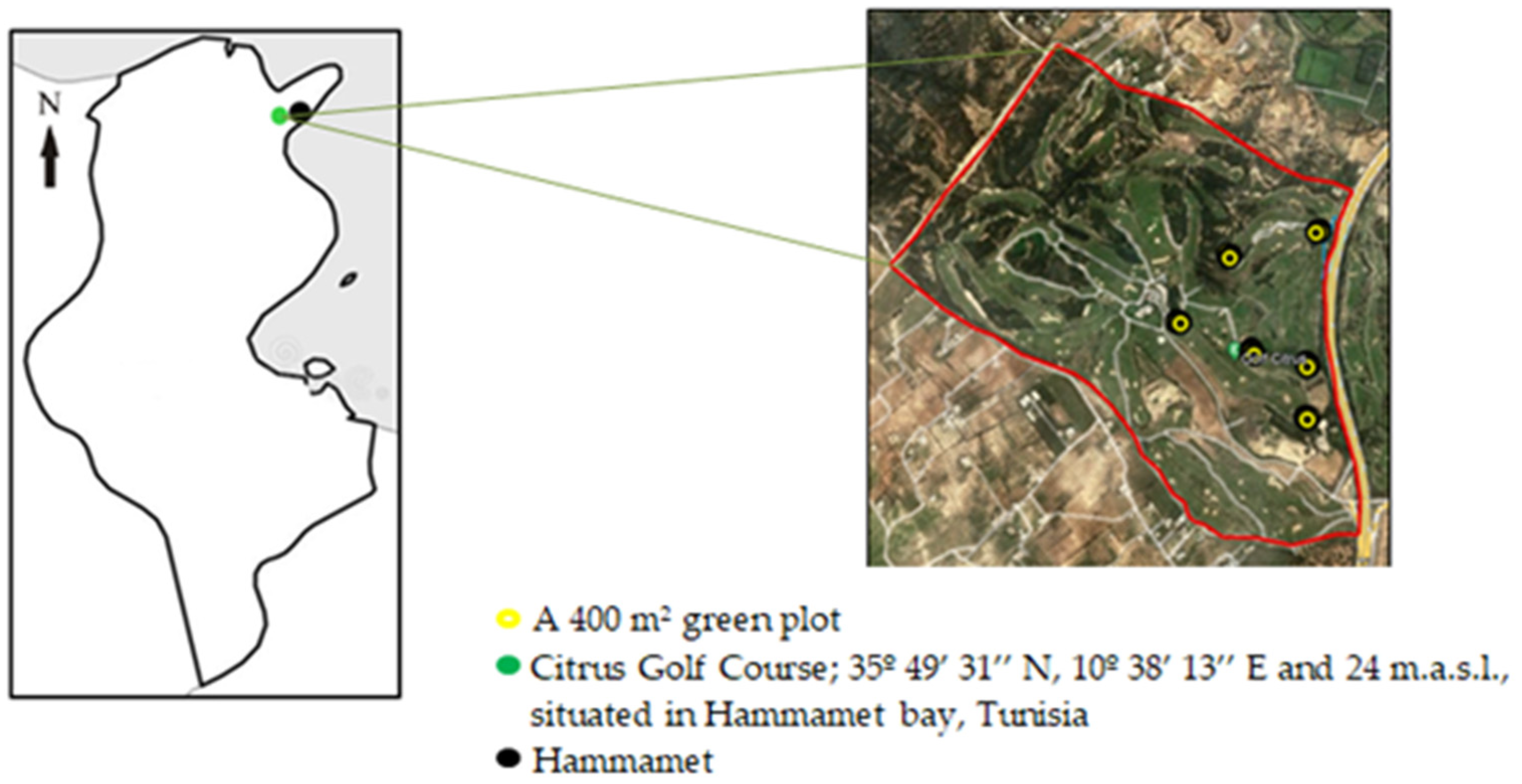

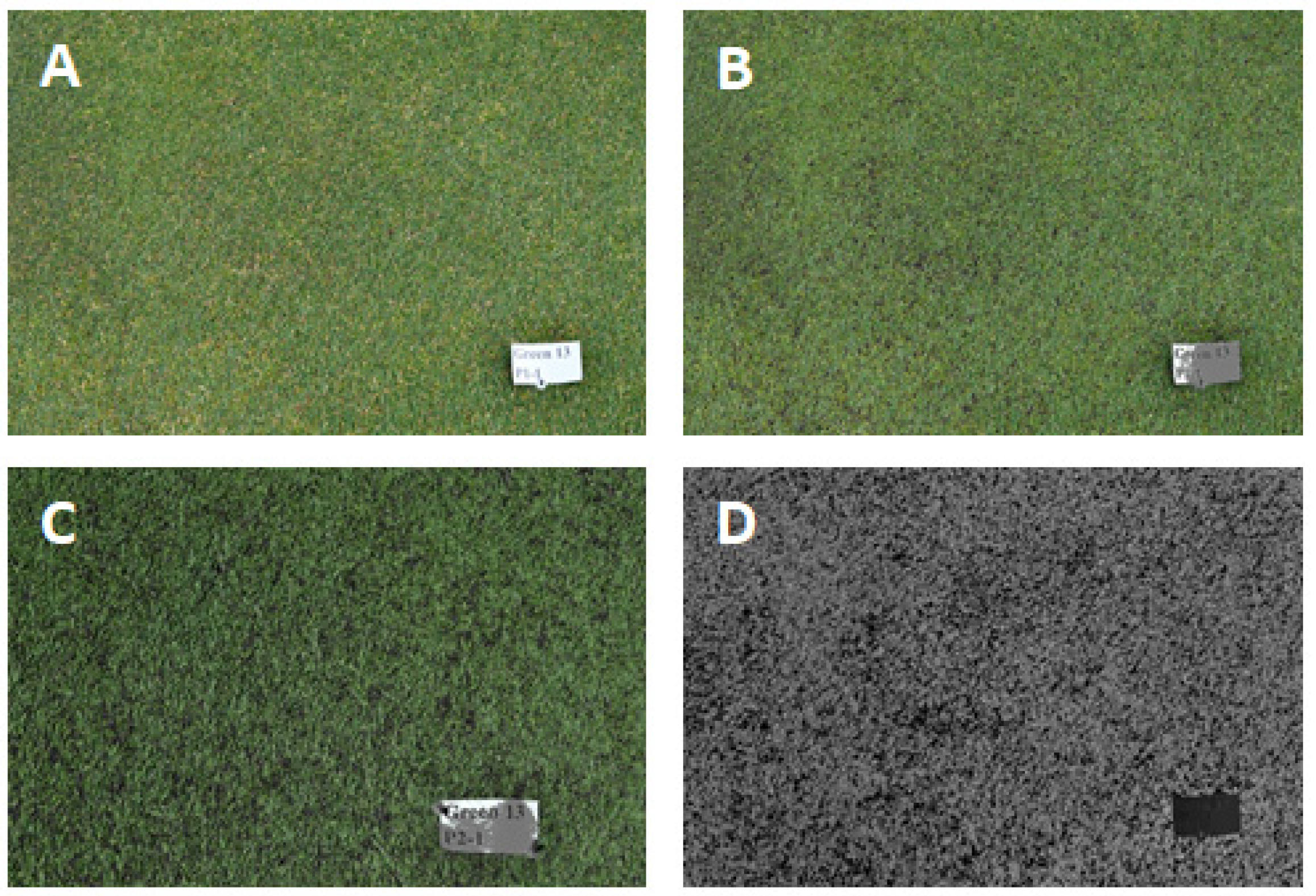
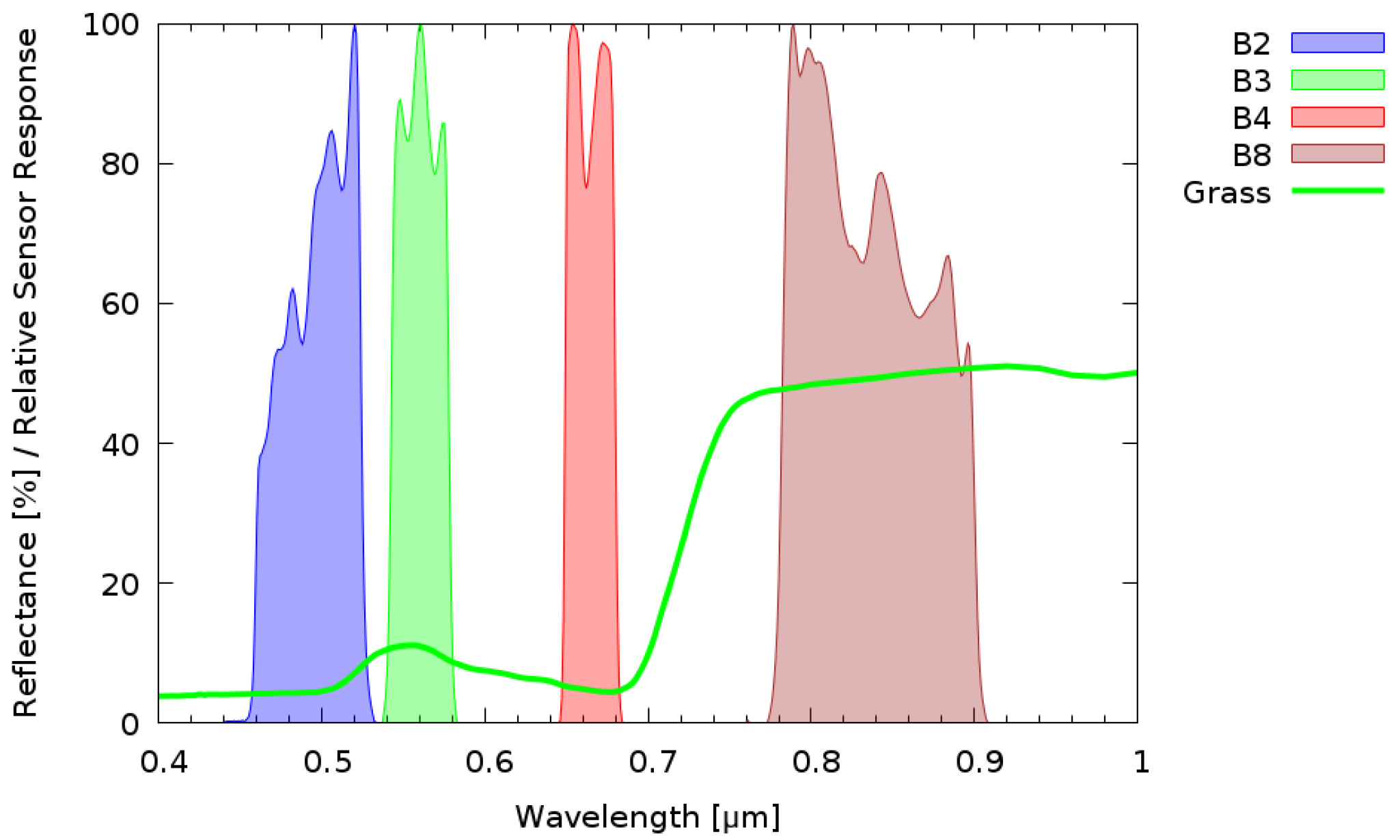
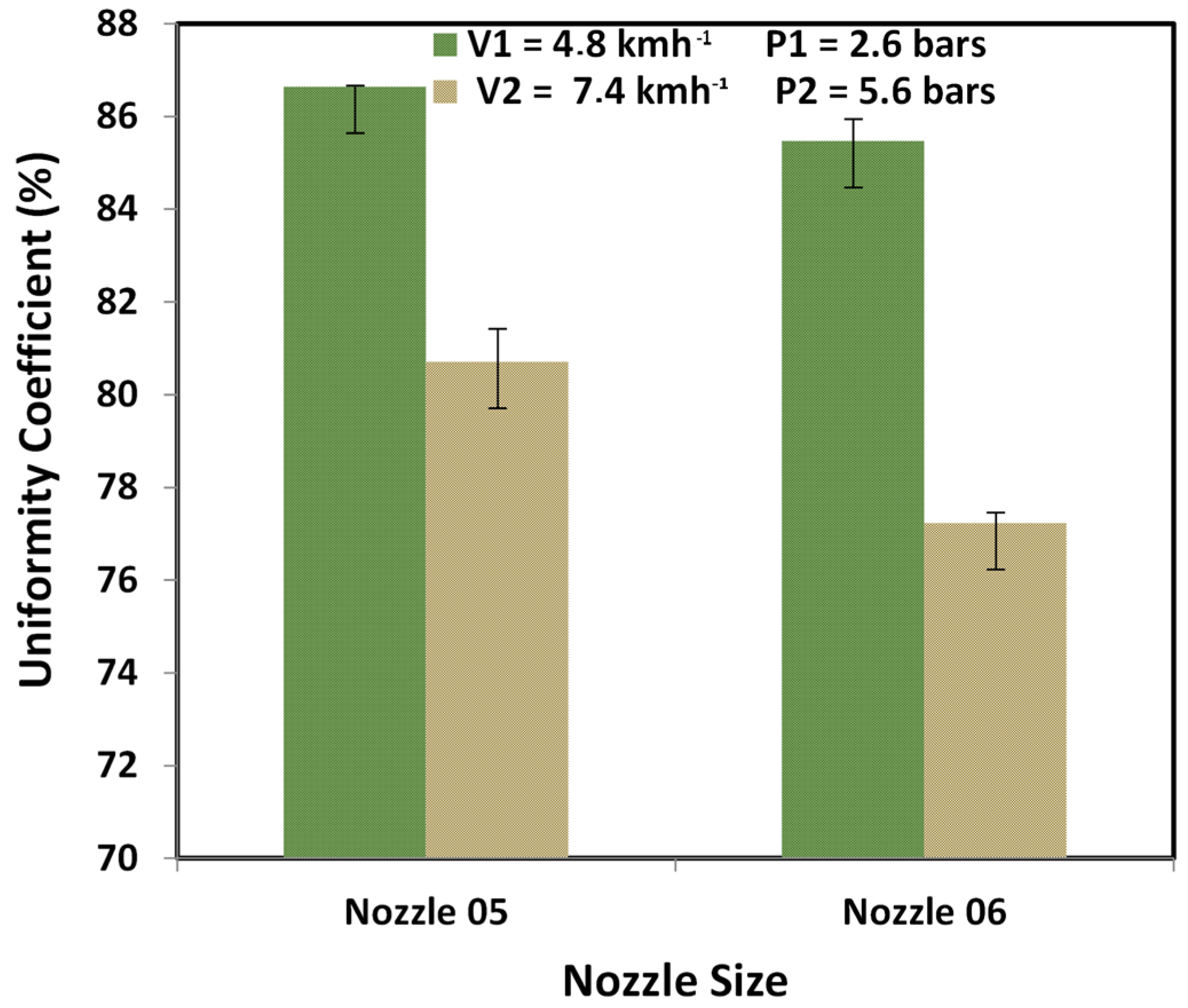


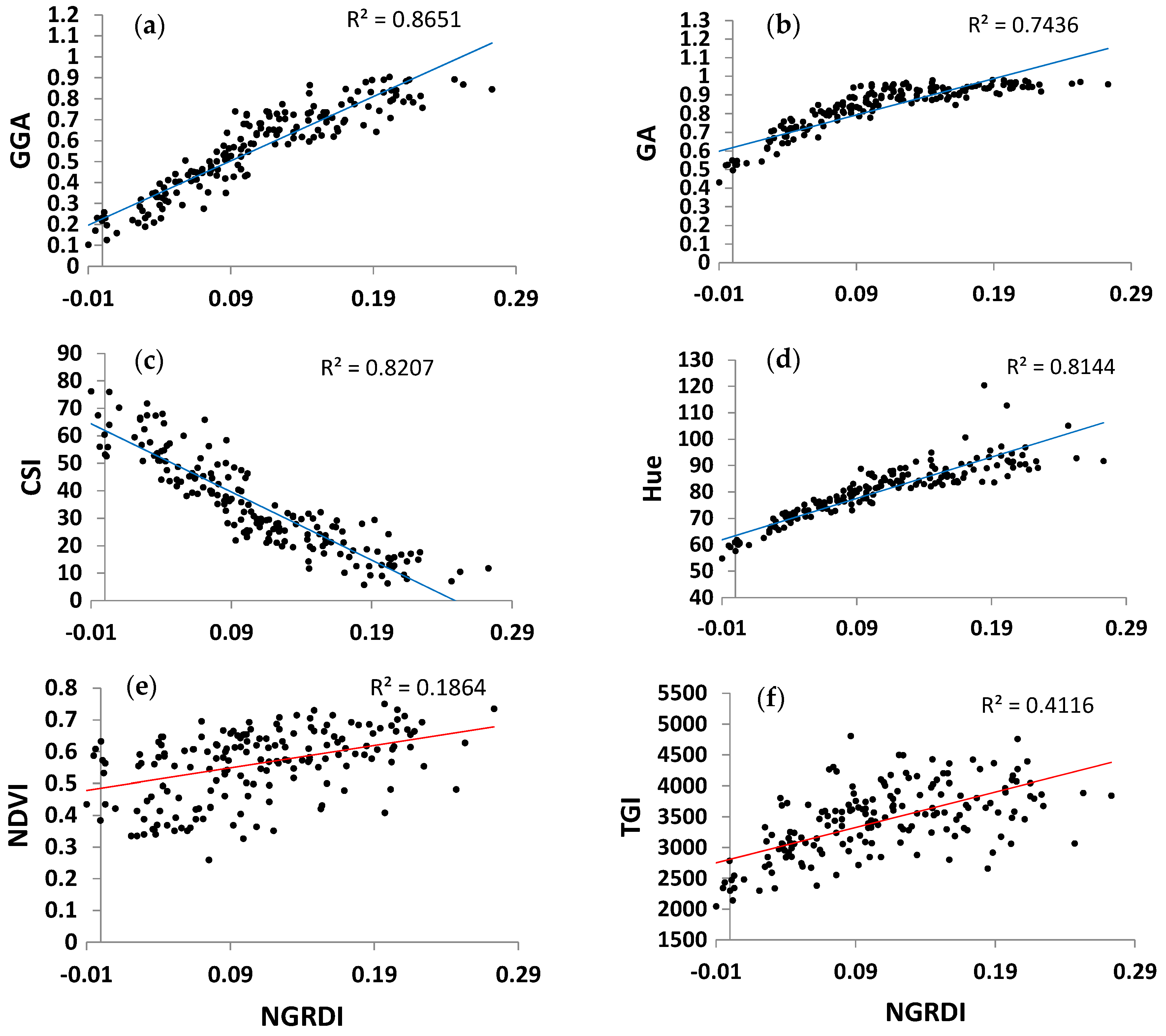
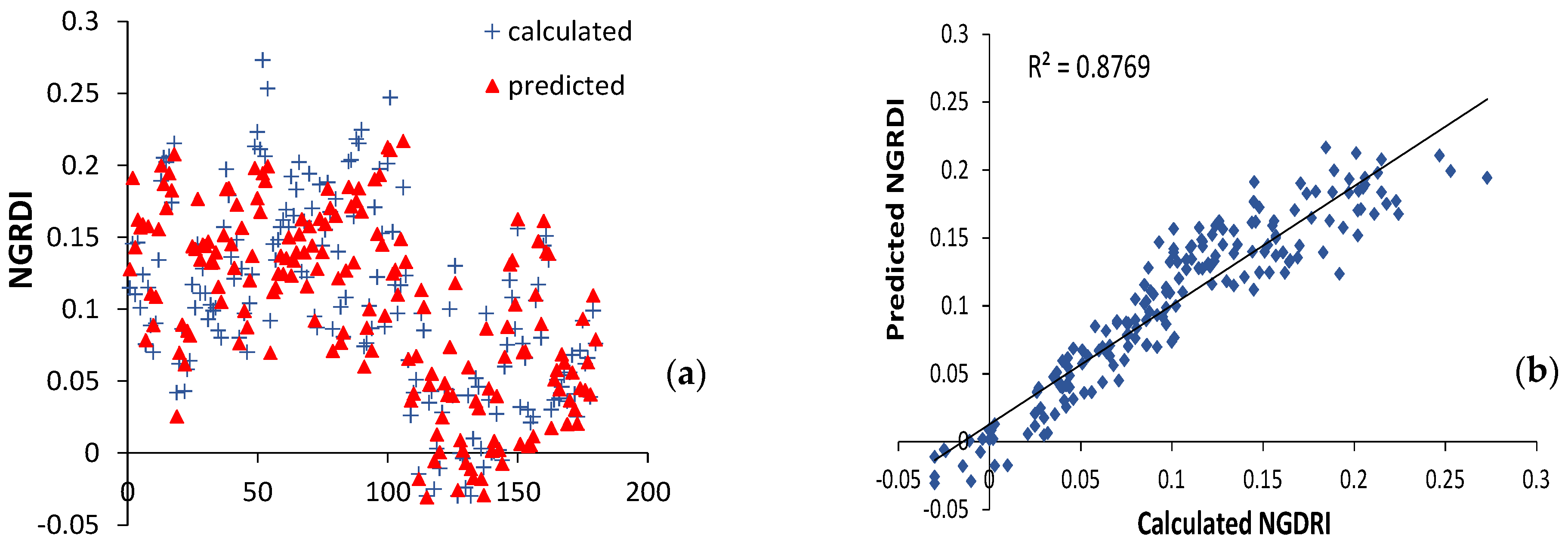
| Treatment | 1 | 2 |
|---|---|---|
| Sprayer | BPS | BPS |
| Nozzle | CHS AXI11005 | CHS AXI11006 |
| Colour and Size | Brown 05 | Grey 06 |
| Number of nozzles | 11 | 11 |
| Pressure (bar) | 5.6 | 2.6 |
| Measured spray liq. flow rate (L min−1) | 3.4 | 1.9 |
| Forward speed (km h−1) | 7.2 | 4.7 |
| Spray volume (L ha−1) | 300 | 300 |
| PTO speed (rpm) | 540 | 540 |
| Nozzles 05 | L min−1 | Status | Nozzles 06 | L min−1 | Status |
|---|---|---|---|---|---|
| 1 | 3.48 | A | 1 | 1.96 | A |
| 2 | 3.42 | A | 2 | 1.86 | A |
| 3 | 3.42 | A | 3 | 1.84 | A |
| 4 | 3.42 | A | 4 | 2 | A |
| 5 | 3.3 | A | 5 | 1.8 | C |
| 6 | 3.48 | A | 6 | 1.96 | A |
| 7 | 3.3 | A | 7 | 1.86 | A |
| 8 | 3.36 | A | 8 | 2 | A |
| 9 | 3.3 | A | 9 | 1.96 | A |
| 10 | 3.42 | A | 10 | 1.92 | A |
| 11 | 3.48 | A | 11 | 1.92 | A |
| Total flow rate | 37.38 | Total flow rate | 21.08 | ||
| Average flow rate (FR) | 3.398 | Average flow rate (FR) | 1.916 | ||
| FR −5% | 3.22 | FR −5% | 1.8202 | ||
| FR +5% | 3.556 | FR +5% | 2.011 |
| GA | GGA | CSI | NGRDI | TGI | NDVI | ||
|---|---|---|---|---|---|---|---|
| Spray pressure | 2.6 | 0.824 ± 0.141 | 0.543 ± 0.212 | 36.726 ± 17.612 | 0.099 ± 0.061 | 3451.929 ± 557.037 | 0.545 ± 0.111 |
| 5.6 | 0.812 ± 0.158 | 0.545 ± 0.226 | 36.066 ± 18.754 | 0.107 ± 0.071 | 3343.531 ± 626.003 | 0.570 ± 0.104 | |
| Nozzle size | 05 | 0.841 ± 0.142 | 0.587 ± 0.217 | 33.018 ± 18.068 | 0.117 ± 0.068 | 3490.770 ± 596.139 | 0.589 ± 0.104 |
| 06 | 0.795 ± 0.154 | 0.501 ± 0.213 | 39.773 ± 17.680 | 0.089 ± 0.062 | 3304.691 ± 578.984 | 0.527 ± 0.104 | |
| Treatment operations | 1 | 0.902 ± 0.063 | 0.656 ± 0.152 | 28.062 ± 12.794 | 0.115 ± 0.046 | 3651.644 ± 446.768 | 0.617 ± 0.063 |
| 2 | 0.908 ± 0.045 | 0.680 ± 0.121 | 25.548 ± 10.260 | 0.158 ± 0.047 | 3746.222 ± 426.312 | 0.645 ± 0.065 | |
| 3 | 0.905 ± 0.054 | 0.672 ± 0.160 | 26.377 ± 14.331 | 0.145 ± 0.051 | 3569.860 ± 469.783 | 0.576 ± 0.072 | |
| 4 | 0.612 ± 0.159 | 0.278 ± 0.138 | 57.127 ± 12.618 | 0.025 ± 0.041 | 2697.033 ± 412.197 | 0.544 ± 0.075 | |
| 5 | 0.763 ± 0.101 | 0.433 ± 0.166 | 44.865 ± 15.446 | 0.072 ± 0.038 | 3323.892 ± 544.391 | 0.407 ± 0.075 |
| Spray Parameters | Pressure | Nozzle Size | ||
|---|---|---|---|---|
| Remote Sensing Variables | r | p | r | p |
| Intensity | −0.154 | * | −0.015 | ns |
| Hue | 0.016 | ns | 0.159 | * |
| Saturation | 0.025 | ns | −0.031 | ns |
| Lightness | −0.173 | * | 0.011 | ns |
| a* | 0.049 | ns | −0.209 | ** |
| b* | −0.125 | ns | 0.012 | ns |
| u* | 0.028 | ns | −0.203 | ** |
| v* | −0.175 | ** | 0.054 | ns |
| GA | −0.039 | ns | 0.154 | * |
| GGA | 0.005 | ns | 0.197 | *** |
| CSI | −0.018 | ns | −0.187 | * |
| NGRDI | 0.059 | ns | 0.216 | *** |
| TGI | −0.092 | ns | 0.157 | * |
| NDVI | 0.116 | ns | 0.287 | *** |
| Minimum | Maximum | Mean | Median | SD | Skewness | Kurtosis | |
|---|---|---|---|---|---|---|---|
| Hue | 48.371 | 120.353 | 79.568 | 81.501 | 11.486 | −0.255 | 0.930 |
| a* | −22.840 | −4.189 | −15.582 | −16.244 | 3.963 | 0.620 | 0.052 |
| u* | −17.436 | 7.252 | −8.068 | −8.855 | 5.357 | 0.713 | 0.228 |
| GGA | 0.056 | 0.904 | 0.544 | 0.583 | 0.219 | −0.334 | −0.919 |
| NDVI | 0.259 | 0.750 | 0.558 | 0.580 | 0.108 | −0.617 | −0.504 |
| Pressure | 2.600 | 5.600 | 4.100 | 4.100 | 2.121 | ||
| Size | 5.000 | 6.000 | 5.500 | 5.500 | 0.707 |
| Equation | R2 | Durbin-Watson Coefficient | RMSE | F | p-Level |
|---|---|---|---|---|---|
| NGRDI = Pressure * 0.08 + Size * 0.05 + Hue * 0.02 − a * 0.01 + u * 0.01 + GGA * 0.248 + NDVI * 0.09 − 0.301 | 0.88 | 0.87 | 0.023 | 175.05 | *** |
Publisher’s Note: MDPI stays neutral with regard to jurisdictional claims in published maps and institutional affiliations. |
© 2022 by the authors. Licensee MDPI, Basel, Switzerland. This article is an open access article distributed under the terms and conditions of the Creative Commons Attribution (CC BY) license (https://creativecommons.org/licenses/by/4.0/).
Share and Cite
Abrougui, K.; Boughattas, N.E.H.; Belhaj, M.; Buchaillot, M.L.; Segarra, J.; Dorbolo, S.; Amami, R.; Chehaibi, S.; Tarchoun, N.; Kefauver, S.C. Assessing Phytosanitary Application Efficiency of a Boom Sprayer Machine Using RGB Sensor in Grassy Fields. Sustainability 2022, 14, 3666. https://doi.org/10.3390/su14063666
Abrougui K, Boughattas NEH, Belhaj M, Buchaillot ML, Segarra J, Dorbolo S, Amami R, Chehaibi S, Tarchoun N, Kefauver SC. Assessing Phytosanitary Application Efficiency of a Boom Sprayer Machine Using RGB Sensor in Grassy Fields. Sustainability. 2022; 14(6):3666. https://doi.org/10.3390/su14063666
Chicago/Turabian StyleAbrougui, Khaoula, Nour El Houda Boughattas, Meriem Belhaj, Maria Luisa Buchaillot, Joel Segarra, Stéphane Dorbolo, Roua Amami, Sayed Chehaibi, Neji Tarchoun, and Shawn C. Kefauver. 2022. "Assessing Phytosanitary Application Efficiency of a Boom Sprayer Machine Using RGB Sensor in Grassy Fields" Sustainability 14, no. 6: 3666. https://doi.org/10.3390/su14063666
APA StyleAbrougui, K., Boughattas, N. E. H., Belhaj, M., Buchaillot, M. L., Segarra, J., Dorbolo, S., Amami, R., Chehaibi, S., Tarchoun, N., & Kefauver, S. C. (2022). Assessing Phytosanitary Application Efficiency of a Boom Sprayer Machine Using RGB Sensor in Grassy Fields. Sustainability, 14(6), 3666. https://doi.org/10.3390/su14063666







